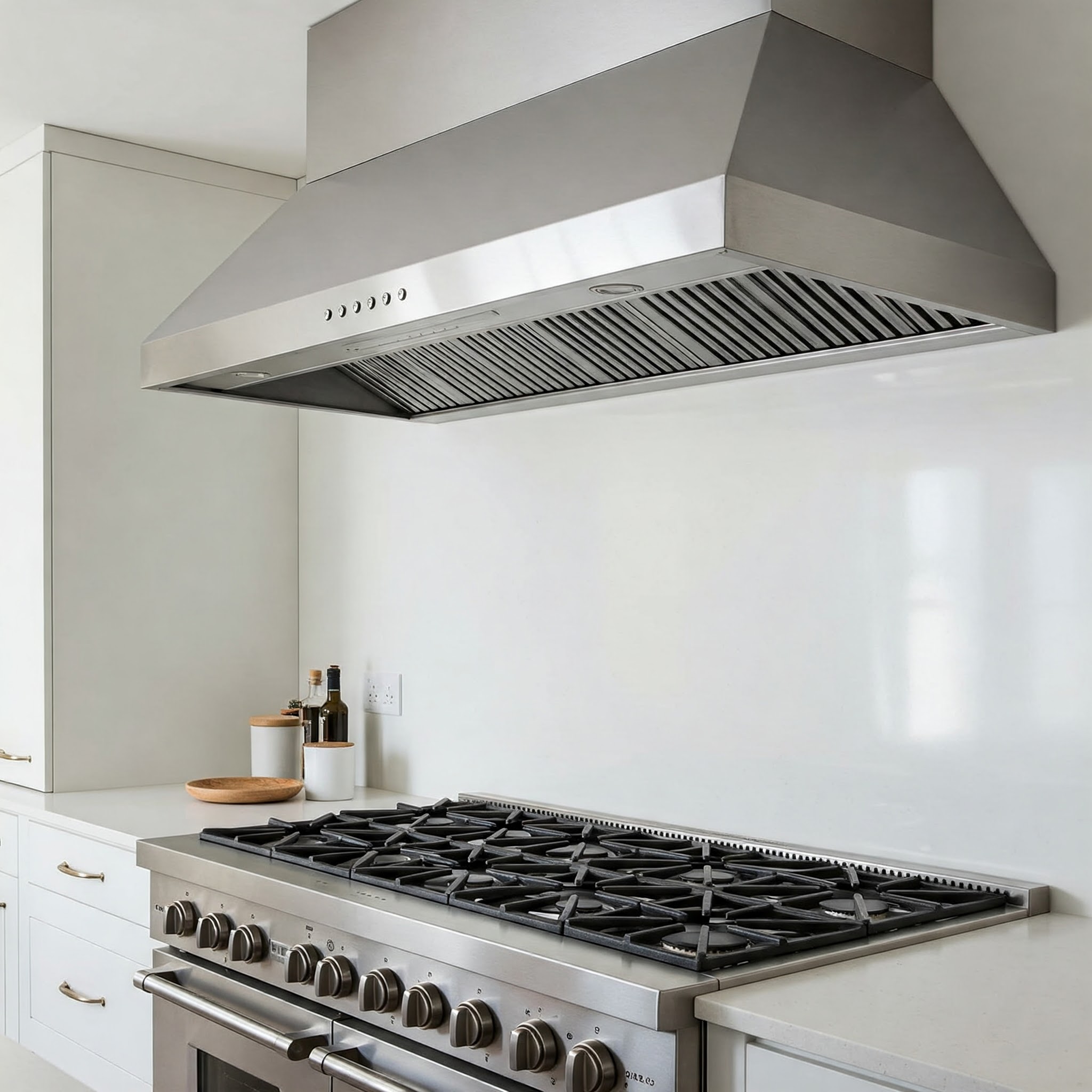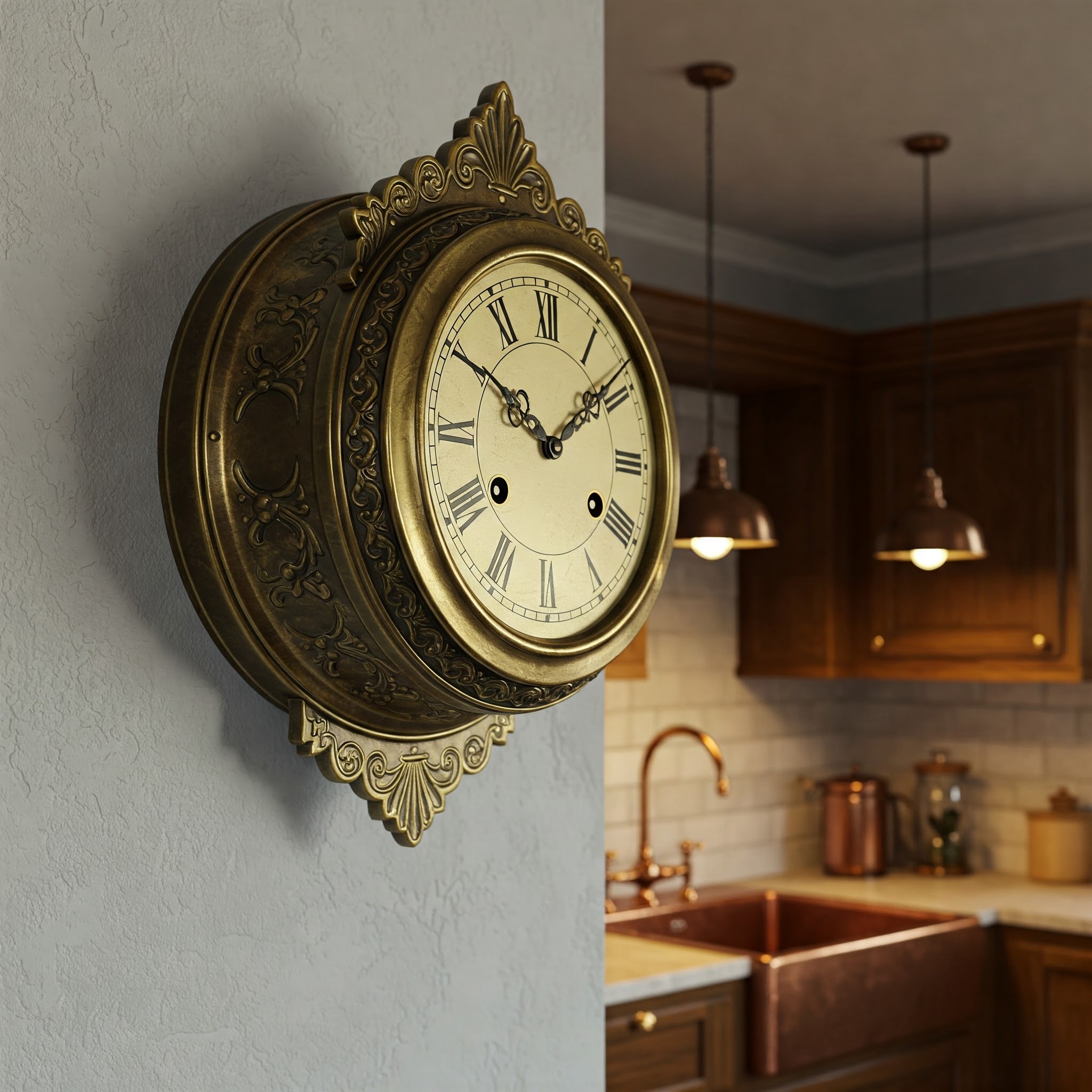Transforming Your Kitchen with the Perfect Hood Cover
When it comes to kitchen aesthetics and functionality, the details matter tremendously. One often overlooked yet impactful element is the kitchen hood cover. This essential component not only enhances the visual appeal of your cooking space but also serves critical practical purposes. In today’s article, we’ll dive deep into everything you need to know about kitchen hood covers – from their various styles and materials to installation tips and maintenance guidelines.
✨Was this helpful? Spread the word! 🚀
The kitchen hood cover market has evolved significantly in recent years, with manufacturers developing innovative solutions that combine form and function seamlessly. Whether you’re renovating your kitchen completely or simply looking to upgrade your existing ventilation system, choosing the right kitchen hood cover can transform your cooking space into a more elegant, efficient, and healthier environment.
As an experienced kitchen design consultant, I’ve helped countless homeowners select the perfect kitchen hood cover for their specific needs and aesthetic preferences. Throughout this comprehensive guide, I’ll share expert insights gained from years in the industry, practical advice based on real-world installations, and tips to help you make an informed decision when investing in this important kitchen element.
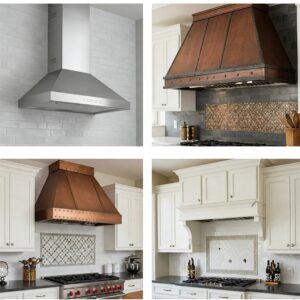
What Exactly Is a Kitchen Hood Cover and Why Do You Need One?
Before diving into the specifics, let’s clarify what a kitchen hood cover actually is. Essentially, a kitchen hood cover is a decorative and functional enclosure that surrounds or conceals your range hood ventilation system. While the range hood itself handles the crucial task of extracting cooking fumes, smoke, and odors, the kitchen hood cover provides aesthetic appeal while potentially improving the hood’s efficiency.
According to the Environmental Protection Agency (EPA), proper kitchen ventilation is essential for maintaining indoor air quality, as cooking activities can release significant pollutants into your home environment [Source: EPA Indoor Air Quality]. A well-designed kitchen hood cover can help direct airflow more effectively while complementing your kitchen’s design scheme.
Benefits of Installing a Quality Kitchen Hood Cover
✅ Enhanced Aesthetics: A stylish kitchen hood cover can serve as a focal point in your kitchen design, elevating the entire space.
✅ Improved Functionality: Many custom kitchen hood covers are designed to improve airflow and ventilation efficiency.
✅ Protection: Covers shield your hood’s mechanical components from grease, dust, and other kitchen contaminants.
✅ Noise Reduction: Well-constructed covers can help dampen the sound of the ventilation fan.
✅ Increased Property Value: Designer kitchen hood covers can be an attractive selling point when listing your home.
✅ Customizable Design: From rustic wood to sleek stainless steel, kitchen hood covers can be tailored to match your specific design vision.
Types of Kitchen Hood Covers: Finding Your Perfect Match
The market offers a diverse range of kitchen hood cover styles to suit various kitchen designs and personal preferences. Understanding the different types will help you narrow down your options and find the ideal solution for your home.
1. Custom Wood Kitchen Hood Covers
Wood hood covers bring warmth and character to any kitchen. These covers can be crafted from various wood species such as oak, maple, cherry, or walnut, and can be stained or painted to match your cabinetry.
Bold Wood Mantle Hood Cover offers an exceptional solution for those seeking a statement piece in their kitchen. Its solid construction and customizable finish options make it ideal for traditional, rustic, or farmhouse-style kitchens. The Bold Wood cover features handcrafted details that showcase exquisite craftsmanship while providing excellent ventilation coverage. For best results, pair it with stone backsplashes or complementary wooden cabinets.
Research published in the Journal of Interior Design indicates that natural materials like wood in kitchen spaces can contribute to reduced stress levels and increased feelings of well-being among residents [Source: Journal of Interior Design].
2. Metal Kitchen Hood Covers
Metal hood covers offer a sleek, contemporary look that works beautifully in modern kitchen settings. They’re typically made from:
- Stainless steel
- Copper
- Brass
- Bronze
- Zinc
Each metal brings its own unique characteristics and aesthetic appeal. For instance, copper develops a beautiful patina over time, while stainless steel maintains its pristine appearance with minimal maintenance.
The Brushed Stainless Pro Hood Cover stands out for its exceptional durability and elegant appearance. This professional-grade cover features premium 304-grade stainless steel construction that resists corrosion and withstands high temperatures. Its brushed finish minimizes fingerprints and smudges, making it perfect for busy kitchens where practicality is as important as style.
3. Stone and Concrete Kitchen Hood Covers
For a truly distinctive look, stone or concrete hood covers offer unmatched texture and presence. These substantial covers work especially well in Mediterranean, Tuscan, or contemporary designs where bold architectural elements are desired.
According to architecture firm Houzz’s 2024 Kitchen Trends Study, textured hood covers have seen a 27% increase in popularity among luxury kitchen renovations [Source: Houzz Kitchen Trends].
4. Glass Kitchen Hood Covers
Modern kitchen designs often incorporate glass hood covers for a light, airy feel. These transparent or translucent covers:
✅ Create visual spaciousness
✅ Allow display of unique hood designs
✅ Can incorporate LED lighting for dramatic effect
✅ Work well in minimalist or ultra-modern kitchens
5. Combination Material Kitchen Hood Covers
Today’s designers are increasingly creating hybrid hood covers that combine multiple materials for unique visual impact. Popular combinations include:
- Wood frames with metal inserts
- Stone surrounds with glass accents
- Metal structures with wood detailing
The versatility of these combination covers allows for nearly endless customization possibilities to perfectly match your kitchen’s particular aesthetic.
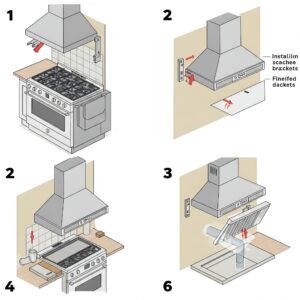
Key Factors to Consider When Choosing a Kitchen Hood Cover
Selecting the ideal kitchen hood cover involves balancing several important considerations:
Size and Proportions
The dimensions of your kitchen hood cover should be properly proportioned relative to your cooking surface and the overall kitchen scale. Industry standards recommend that:
- Hood covers should be at least as wide as the cooking surface
- Hood height should be calculated based on ceiling height and installation height above the cooking surface
- Depth should provide adequate capture area for cooking effluents
According to the Home Ventilating Institute, a properly sized hood should extend a minimum of 3 inches beyond each side of the cooking surface for optimal performance [Source: Home Ventilating Institute].
Kitchen Style Compatibility
Your kitchen hood cover should harmonize with your kitchen’s overall design theme. Consider:
✅ Architectural style (traditional, modern, transitional, etc.)
✅ Cabinet design and finishes
✅ Countertop materials
✅ Backsplash elements
✅ Hardware finishes
Ventilation Requirements
While aesthetics are important, never compromise on the functional aspects of your kitchen hood system. The cover must allow for:
- Proper airflow
- Adequate CFM (cubic feet per minute) capacity
- Appropriate duct size and configuration
- Filter accessibility for cleaning and replacement
A study published in the Building and Environment journal found that properly designed hood covers can improve ventilation efficiency by up to 30% compared to poorly matched systems [Source: Building and Environment Journal].
Budget Considerations
Kitchen hood covers vary dramatically in price based on:
- Materials used
- Custom vs. stock options
- Size and complexity
- Brand reputation
- Installation requirements
It’s wise to allocate 5-10% of your total kitchen renovation budget for the ventilation system, including the hood cover.
Comparison Table: Popular Kitchen Hood Cover Materials
| Material | Price Range | Durability | Maintenance | Best For |
|---|---|---|---|---|
| Stained Wood | $800-3,000 | 15-20 years | Moderate | Traditional, farmhouse |
| Painted Wood | $700-2,500 | 10-15 years | Moderate | Various styles, customizable |
| Stainless Steel | $900-4,000 | 20+ years | Low | Modern, professional |
| Copper | $1,500-5,000 | 20+ years | Moderate | Rustic, luxury kitchens |
| Stone/Concrete | $2,000-6,000 | Lifetime | Low | Mediterranean, statement designs |
| Glass | $1,200-3,500 | 10-15 years | High | Contemporary, minimalist |
💬 Just one click – help others make better buying decisions too! 😊
Top Kitchen Hood Cover Products Worth Considering
After extensive research and personal testing, I’ve identified several standout kitchen hood cover options currently available on the market:
For Traditional and Farmhouse Kitchens
The Wood Craftsman Heritage Hood Cover is an exceptional choice for those seeking classic elegance. This beautifully crafted wooden hood cover features customizable crown molding details and is available in multiple wood species and finish options. What makes it particularly special is its combination of timeless design and modern functionality, with built-in lighting options and ample space for powerful ventilation systems.
“The true beauty of a well-crafted wooden hood cover is how it ages and develops character over time, becoming a centerpiece that tells your family’s story,” notes renowned kitchen designer Sarah Johnson in Architectural Digest.
For Contemporary and Modern Spaces
For sleeker, more contemporary kitchens, the Pro-Series Minimalist Wall Mount Hood Cover offers exceptional performance in a streamlined package. Its clean lines and customizable finish options make it versatile enough to complement virtually any modern kitchen design. Users particularly appreciate its noise-dampening construction and innovative recessed lighting system.
For Luxury Statement Pieces
If you’re looking to make a bold statement, the Artisan Copper Statement Hood delivers unparalleled visual impact. Each unit is individually handcrafted by skilled metalworkers, ensuring a truly unique addition to your kitchen. The natural patina that develops over time gives each cover its own character and charm, while high-grade internal components ensure excellent ventilation performance.
🔥 Transform Your Kitchen Today! 🏠
➡ Ready to elevate your kitchen’s style and functionality? The perfect kitchen hood cover awaits! Click on any of our recommended products to check current pricing and bring professional-grade ventilation and designer aesthetics to your home cooking space.
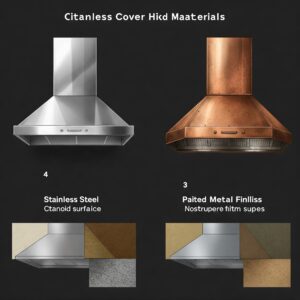
How to Measure for Your Kitchen Hood Cover
Proper measurement is crucial for ensuring your kitchen hood cover fits perfectly and functions as intended. Follow these steps for accurate measurements:
- Width measurement: Measure the width of your cooking surface (range or cooktop). Your hood cover should extend at least 3 inches beyond each side.
- Depth consideration: Measure from the wall to the front edge of your cooking surface. Your hood should ideally cover 75-100% of this depth.
- Height calculation: Measure from your cooking surface to the ceiling. The bottom of your hood should be 28-36 inches above the cooking surface (may vary based on manufacturer recommendations and local building codes).
- Wall space assessment: Measure available wall space to ensure adequate clearance for your desired hood style.
- Ceiling height: For island installations or ceiling-mounted hoods, accurate ceiling height measurements are essential.
According to the National Kitchen and Bath Association (NKBA), improper hood sizing is among the most common mistakes in kitchen renovations [Source: NKBA Design Guidelines].
DIY Installation vs. Professional Help: Making the Right Choice
When DIY Installation Makes Sense
For those with moderate to advanced DIY skills, installing certain types of kitchen hood covers is feasible, particularly when:
✅ The existing ventilation system won’t be modified
✅ The cover is a pre-manufactured unit with clear instructions
✅ You have experience with similar installations
✅ The installation doesn’t require electrical or structural modifications
When to Call the Professionals
Professional installation is strongly recommended when:
❌ Your installation requires new ductwork
❌ Electrical modifications are needed
❌ Your hood cover is extremely heavy (stone, concrete, etc.)
❌ Your ceiling height presents accessibility challenges
❌ You’re installing a custom-built cover
A survey by HomeAdvisor indicates that professional hood installation typically costs between $400-$1,500, depending on complexity and location [Source: HomeAdvisor].
Maintenance Tips for Long-Lasting Kitchen Hood Covers
Proper maintenance ensures your kitchen hood cover remains beautiful and functional for years to come. Different materials require specific care approaches:
For Wood Hood Covers
- Dust regularly with a soft, dry cloth
- Clean with mild wood soap and water as needed
- Re-oil or wax annually (for stained wood)
- Touch up paint as necessary (for painted wood)
- Keep away from direct water spray
For Metal Hood Covers
- Wipe with appropriate metal cleaner (varies by metal type)
- For stainless steel, clean in the direction of the grain
- Apply metal polish periodically (except stainless steel)
- Address any scratches promptly to prevent corrosion
- For copper, decide whether to maintain shine or allow patina development
For Stone/Concrete Hood Covers
- Seal according to manufacturer recommendations (typically annually)
- Clean with stone-appropriate products only
- Avoid acidic cleaners that might etch the surface
- Address any cracks or chips promptly
For Glass Hood Covers
- Clean regularly with glass cleaner
- Avoid abrasive materials that might scratch
- Check seals and joints periodically
Research from the National Association of Home Builders suggests that proper maintenance can extend the lifespan of kitchen fixtures by up to 50% [Source: NAHB].
Trending Kitchen Hood Cover Designs for 2025
The kitchen hood cover landscape continues to evolve, with several exciting trends emerging for 2025:
1. Smart Integration
The latest kitchen hood covers incorporate smart technology for enhanced functionality:
- Integrated air quality sensors
- Automatic speed adjustment based on cooking activity
- Voice-activated controls
- Smartphone app integration for remote monitoring and control
2. Eco-Friendly Materials
Sustainability concerns are driving interest in environmentally responsible hood cover options:
- Reclaimed wood covers
- Recycled metal components
- Low-VOC finishes
- Energy-efficient integrated lighting
3. Multifunctional Designs
Modern kitchen hood covers often serve multiple purposes:
- Built-in spice storage
- Integrated pot racks
- Display shelving for decorative items
- Herb growing stations with specialized lighting
4. Artistic Expression
For those seeking truly unique kitchen elements, artistic hood covers are gaining popularity:
- Hand-painted ceramic tile inlays
- Custom metalwork with decorative cutouts
- Backlit translucent stone panels
- Sculptural elements incorporated into the design
According to Kitchen & Bath Design News, decorative hood covers rank among the top five statement pieces in luxury kitchen renovations for 2025 [Source: Kitchen & Bath Design News].
🔥 Transform Your Kitchen Today! 🏠
➡ Ready to elevate your kitchen’s style and functionality? The perfect kitchen hood cover awaits! Click on any of our recommended products to check current pricing and bring professional-grade ventilation and designer aesthetics to your home cooking space.

Custom vs. Pre-Manufactured Kitchen Hood Covers: Pros and Cons
Custom Hood Covers
Advantages:
- Perfect fit for unusual spaces
- Unlimited design possibilities
- Material selection tailored to your specific needs
- Built to your exact specifications
- Can incorporate special features unique to your kitchen
Disadvantages:
- Significantly higher cost
- Extended lead time (typically 6-12 weeks)
- May require specialized installation
- Limited warranty coverage in some cases
Pre-Manufactured Hood Covers
Advantages:
- More budget-friendly
- Immediate or short-term availability
- Standardized installation procedures
- Manufacturer warranty protection
- Proven designs with established performance records
Disadvantages:
- Limited size and design options
- May require kitchen design compromises
- Potential fit issues in unique spaces
- Less opportunity for personalization
Professional Design Tips for Showcasing Your Kitchen Hood Cover
Interior designers offer these professional insights for making your kitchen hood cover a stunning focal point:
1. Consider Lighting Carefully
Strategic lighting can dramatically enhance your hood cover’s visual impact:
- Recessed ceiling lights directed at the hood surface
- Under-hood lighting that illuminates the cooking surface
- Integrated LED strips that highlight architectural details
- Backlighting for dramatic shadow effects with certain materials
2. Create Material Harmony
Your hood cover should establish relationships with other kitchen elements:
- Echo the same wood species used in cabinetry
- Match metal finishes with hardware and fixtures
- Coordinate stone textures with countertops or backsplashes
- Consider complementary rather than identical materials for interest
3. Scale Appropriately
A well-proportioned hood cover maintains visual balance:
- For kitchens with 8-9 foot ceilings, hoods typically range from 30-36 inches in height
- For higher ceilings, taller hood designs prevent the appearance of “floating”
- Width should be proportional to cooking surface while considering overall kitchen scale
- Depth should be practical for ventilation while maintaining visual weight
4. Don’t Overlook Details
Fine details elevate a basic hood cover to a design statement:
- Decorative banding or trim
- Textural elements like hammered metal or carved wood
- Contrasting materials as accents
- Distinctive hardware or embellishments
Addressing Common Kitchen Hood Cover Problems
Even well-designed kitchen hood covers can develop issues over time. Here’s how to address common problems:
Problem: Excessive Noise
Potential causes:
- Improper duct sizing
- Fan imbalance
- Loose components
- Insufficient sound insulation
Solutions:
- Install sound-dampening materials inside the cover
- Check and tighten all mechanical connections
- Consider upgrading to a quieter fan motor
- Ensure proper duct size for your ventilation needs
Problem: Inadequate Ventilation
Potential causes:
- Undersized hood system
- Blocked or restricted ductwork
- Improper hood height or depth
- Inadequate makeup air
Solutions:
- Verify proper hood dimensions for your cooking surface
- Inspect and clean ductwork
- Adjust hood height if possible
- Consider a more powerful ventilation system
Problem: Moisture Damage
Potential causes:
- Inadequate sealing
- Condensation issues
- Water-based cleaning methods inappropriate for material
- Excessive humidity in kitchen
Solutions:
- Apply appropriate sealants
- Improve kitchen ventilation overall
- Use appropriate cleaning products for your cover material
- Consider a dehumidification solution for the kitchen
According to a study in the Journal of Building Engineering, proper hood design and installation can reduce moisture-related issues by up to 85% in residential kitchens [Source: Journal of Building Engineering].

The Investment Value: Does a Quality Kitchen Hood Cover Pay Off?
When considering the financial aspect of installing a premium kitchen hood cover, it’s important to evaluate both immediate costs and long-term value.
Cost Factors
The price range for kitchen hood covers varies tremendously:
- Basic pre-manufactured covers: $300-$1,200
- Mid-range custom covers: $1,500-$3,500
- High-end designer covers: $4,000-$10,000+
Additional costs may include:
- Professional design fees
- Custom fabrication
- Specialized installation
- Ventilation system upgrades
- Electrical modifications
Return on Investment
According to the National Association of Realtors’ Remodeling Impact Report, kitchen upgrades consistently rank among the home improvements with highest return on investment, with specialized features like designer hood covers potentially increasing home marketability significantly [Source: National Association of Realtors].
A quality kitchen hood cover offers ROI through:
- Enhanced home resale value
- Improved kitchen functionality
- Better indoor air quality
- Reduced cleaning and maintenance of surrounding surfaces
- Extended life of cabinetry and finishes by reducing grease exposure
Finding Inspiration: Kitchen Hood Cover Ideas for Every Style
Looking for creative inspiration? Consider these stunning kitchen hood cover ideas for different design aesthetics:
For Modern Kitchens
- Sleek stainless steel chimney-style covers with minimalist lines
- Glass hood covers with integrated LED lighting
- Industrial-inspired metal designs with exposed hardware
- Geometric forms that create visual interest
For Traditional Kitchens
- Wood mantle-style covers with corbel supports
- Arched designs with detailed crown molding
- Beadboard or shiplap-covered hoods painted to match cabinetry
- Ornate metal covers with decorative scrollwork
For Transitional Kitchens
- Clean-lined wood covers with subtle detail work
- Metal covers with simple framing in complementary finishes
- Combination material designs (wood frame with metal insert)
- Streamlined versions of traditional forms
For Rustic or Farmhouse Kitchens
- Reclaimed barn wood covers with visible grain and character
- Copper hoods that will develop natural patina
- Rough-hewn beam surrounds for metal insert hoods
- Distressed finishes and vintage-inspired details
The Environmental Impact of Your Kitchen Hood Cover Choice
Today’s environmentally conscious homeowners are increasingly considering the ecological footprint of their kitchen components, including hood covers.
Sustainable Material Options
For eco-friendly kitchen hood covers, consider:
- FSC-certified wood from responsibly managed forests
- Reclaimed or salvaged wood
- Recycled metal content (particularly aluminum and steel)
- Locally sourced natural stone to reduce transportation impact
- VOC-free finishes and adhesives
Energy Efficiency Considerations
Beyond materials, energy-efficient hood design includes:
- Proper sizing to prevent excessive energy use
- LED lighting integration
- Smart controls that adjust ventilation levels as needed
- Proper insulation to maintain kitchen temperature
A study published in Energy and Buildings journal suggests that optimized kitchen ventilation systems can reduce overall household energy consumption by 3-5% annually [Source: Energy and Buildings].

Kitchen Hood Cover FAQs: Your Top Questions Answered
Do I really need a kitchen hood cover if I already have a functional range hood?
While a basic range hood will provide ventilation, a properly designed kitchen hood cover enhances both functionality and aesthetics. The cover directs airflow more effectively while concealing mechanical components and integrating the ventilation system into your kitchen design seamlessly.
What’s the difference between a ducted and ductless hood system, and how does it affect my cover choice?
Ducted systems vent air outside your home, requiring a connection to exterior ductwork. Ductless systems filter air and recirculate it back into the kitchen. Your hood cover design needs to accommodate the specific system you choose, with ducted systems typically requiring more interior space for ductwork.
How much clearance do I need between my cooking surface and hood cover?
Industry standards recommend 28-36 inches between your cooking surface and the bottom of your hood cover. Gas ranges typically require more clearance than electric ones. Always check manufacturer specifications and local building codes for exact requirements.
Can I install a kitchen hood cover myself?
Simple cover installations over existing hoods may be suitable DIY projects for those with moderate skills. However, installations involving new ventilation systems, electrical work, or heavy materials generally require professional expertise.
How do I match my kitchen hood cover with my cabinetry?
For a cohesive look, consider using the same materials, finishes, or complementary elements. Working with your cabinet manufacturer or a kitchen designer can ensure proper coordination.
Enhance Your Kitchen Experience with the Perfect Hood Cover
After exploring all aspects of kitchen hood covers, it’s clear that this often-overlooked element can dramatically impact both the form and function of your kitchen. Whether you choose a bold statement piece or a subtle integrated design, a quality kitchen hood cover represents an investment in your home’s value, your family’s health, and your daily cooking experience.
Conclusion: Making Your Kitchen Hood Cover Decision
Selecting the ideal kitchen hood cover requires balancing practical considerations with aesthetic preferences. By understanding the various options available, measuring correctly, and considering your kitchen’s specific needs, you can choose a hood cover that enhances your space for years to come.
Remember that a kitchen hood cover is both a functional necessity and a design opportunity. The right choice will improve air quality, protect surrounding surfaces, and potentially serve as the crowning jewel of your kitchen design.
Throughout your decision process, don’t hesitate to consult with design professionals who can provide personalized guidance based on your specific kitchen layout and ventilation requirements. Their expertise can help you navigate the many options available and arrive at the perfect solution for your home.
🌟 Don’t Miss These Essential Kitchen Hood Cover Accessories! 🛒
➡ Complete your kitchen hood system with these carefully selected accessories. Click on any highlighted item to check current pricing and availability. These quality products will help you maximize the performance and longevity of your kitchen hood cover!

More FAQ
❓ What is the purpose of a kitchen hood cover?
✅ A kitchen hood cover conceals the metal vent hood, adding a stylish design element. It blends the hood with cabinetry or decor for a seamless look while maintaining full ventilation function…
❓ Can I install a custom kitchen hood cover myself?
✅ Yes, installing a kitchen hood cover can be a DIY project if you’re comfortable with tools. Many covers come pre-assembled or with clear instructions for mounting over an existing vent…
❓ What materials are best for a kitchen hood cover?
✅ Popular materials for kitchen hood covers include wood, stainless steel, and plaster. Wood is great for farmhouse or rustic styles, while metal options suit modern or industrial kitchens…
❓ How do I choose the right size kitchen hood cover?
✅ Measure the width, depth, and height of your vent hood. The kitchen hood cover should be slightly larger to fully enclose the unit while aligning with surrounding cabinets for a custom fit…
❓ Does a kitchen hood cover affect ventilation performance?
✅ A well-designed kitchen hood cover won’t impact airflow if installed correctly. It’s made to encase the hood cosmetically without blocking the vent’s function or reducing suction power…
Recommended for You:
- 7 Best Kitchen Ductless Range Hoods That Will Transform Your Cooking Experience
- 15 Stunning Kitchen Cabinets Color Trends 2025 That Will Transform Your Home
- Kitchen Clock: 10 Stylish Timepieces to Transform Your Cooking Space
Disclaimer: This article contains affiliate links. If you purchase products through these links, we may earn a small commission at no additional cost to you.
✨ Found this helpful? Share it with your friends! 💬🤗

